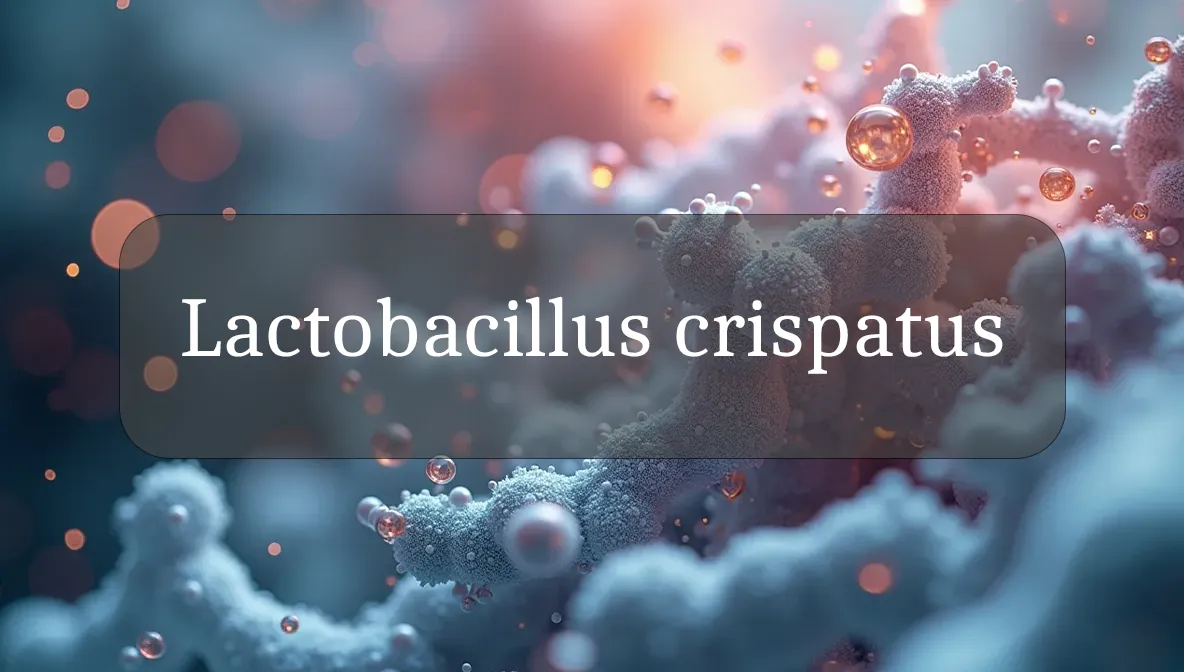Vaginal Microbiome’s Guardian for Balance and Wellness
Lactobacillus crispatus is like the vigilant protector of your vaginal microbiome, a beneficial bacterium that maintains a healthy, acidic environment to ward off infections. As a dominant species in a healthy vaginal ecosystem, it’s a key focus for health-conscious folks aiming to support reproductive and overall wellness. Understanding L. crispatus can empower you to make choices that promote vaginal health. Let’s explore what L. crispatus is, why it matters, and how you can nurture its role for daily vitality!
Chemical Identity and Type
Lactobacillus crispatus is a Gram-positive, rod-shaped bacterium, a facultative anaerobe that thrives in low-oxygen environments like the vaginal mucosa. It’s a lactic acid-producing microbe, part of the Lactobacillus genus, and one of the most prevalent species in a healthy vaginal microbiome. Found primarily in the vagina and sometimes in the gut, it ferments sugars into lactic acid, maintaining an acidic pH (3.5–4.5). Think of it as a diligent gardener, keeping the vaginal environment lush and hostile to harmful microbes.
Biological Role and Benefits
L. crispatus is a cornerstone of vaginal health, offering these benefits when dominant:
- Vaginal pH Regulation: It produces lactic acid, keeping the vaginal pH acidic, which inhibits the growth of pathogens like Gardnerella vaginalis or Candida.
- Pathogen Defense: Through competitive exclusion and antimicrobial compounds (e.g., bacteriocins, hydrogen peroxide), it prevents infections like bacterial vaginosis (BV) or yeast infections.
- Immune Support: L. crispatus modulates local immune responses, reducing inflammation and supporting mucosal integrity.
- Pregnancy Health: Its dominance is linked to lower risks of preterm birth and infections during pregnancy.
- Microbiome Stability: It promotes a diverse, balanced vaginal microbiome, fostering resilience against disruptions.
A robust L. crispatus population supports vaginal health, reduces infection risk, and enhances overall vitality.
Dietary or Natural Sources
L. crispatus is a naturally occurring bacterium in the vaginal and gut microbiomes, not directly sourced from food. However, you can support its growth and dominance with these nutrient-rich choices:
- Probiotic-Rich Foods: Yogurt, kefir, and fermented foods (e.g., sauerkraut, kimchi) with Lactobacillus strains (ideally L. crispatus or similar) promote a healthy microbiome.
- Prebiotic-Rich Foods: Garlic, onions, bananas, and asparagus feed beneficial bacteria, supporting L. crispatus growth.
- Vitamin D-Rich Foods: Fatty fish, egg yolks, or fortified foods (or 10–30 minutes of sunlight exposure) support mucosal immunity, aiding L. crispatus function.
- Antioxidant-Rich Foods: Berries, leafy greens, and green tea reduce inflammation, fostering a balanced vaginal environment.
A balanced diet with probiotics and prebiotics promotes L. crispatus dominance and vaginal health.
Signs of Imbalance or Dysfunction
A decline in L. crispatus (often due to antibiotics, hormonal changes, or douching) may lead to microbiome dysbiosis, showing up as:
- Bacterial Vaginosis (BV): Thin, grayish discharge with a fishy odor, itching, or burning, often from L. crispatus being overtaken by Gardnerella vaginalis.
- Yeast Infections: Itching, thick white discharge, or redness from Candida overgrowth, linked to reduced L. crispatus protection.
- Increased Infection Risk: Higher susceptibility to STIs (e.g., HIV, chlamydia) or urinary tract infections due to weakened vaginal defenses.
- Vaginal Discomfort: Irritation, dryness, or inflammation from an elevated pH (>4.5).
- Pregnancy Complications: Low L. crispatus levels may increase risks of preterm birth or infections in pregnant women.
These symptoms can have many causes, so consult a healthcare provider if they persist to explore vaginal or microbiome issues.
Supporting Optimal Levels or Function
To promote L. crispatus dominance and maintain vaginal health, try these evidence-based tips:
- Eat Probiotic Foods: Consume yogurt or fermented foods with Lactobacillus strains (e.g., L. crispatus, L. reuteri) to support vaginal microbiome health. Look for products specifying live cultures.
- Avoid Douching: Douching disrupts L. crispatus and raises vaginal pH, increasing BV risk. Use only mild, unscented soap for external cleaning.
- Wear Breathable Clothing: Choose cotton underwear and avoid tight clothing to reduce moisture, creating a favorable environment for L. crispatus.
- Limit Antibiotics: Use antibiotics only as prescribed, as they can kill L. crispatus and promote pathogens. Consider probiotics during antibiotic use, with medical guidance.
- Manage Hormones and Stress: Balanced estrogen levels (e.g., via diet or medical support) and stress reduction (e.g., yoga, meditation) support L. crispatus growth, as stress or hormonal shifts can disrupt the microbiome.
Small, consistent habits foster a L. crispatus-dominant vaginal microbiome for optimal health.
Safety, Interactions, and Precautions
L. crispatus is a beneficial bacterium and safe when dominant, but consider these factors:
- Microbiome Disruptions: Antibiotics, douching, or high-sugar diets can reduce L. crispatus, leading to BV (20–40% prevalence in women) or yeast infections.
- Probiotic Supplements: Vaginal or oral L. crispatus probiotics (e.g., strains like CTV-05) may reduce BV recurrence (studies show 30–50% efficacy), but effects vary. Consult a healthcare provider before use.
- Hormonal Changes: Menstruation, pregnancy, or menopause can lower L. crispatus due to pH or glycogen shifts. Hormone therapy or probiotics may help, under medical guidance.
- Infection Risks: A L. crispatus-poor microbiome increases STI or preterm birth risks (2–3 times higher with BV). Seek prompt treatment for symptoms.
- Allergies or Sensitivities: Probiotic supplements may cause mild bloating or irritation in rare cases. Choose high-quality, tested products.
Supporting L. crispatus involves microbiome-friendly habits and cautious use of treatments.
Fun Fact
Did you know L. crispatus is a superstar at keeping your vaginal pH low? It churns out so much lactic acid that it creates an acidic fortress, making it tough for harmful microbes to crash the party!
Citations
- National Institutes of Health (NIH): Vaginal Microbiome and Lactobacillus Species.
- Centers for Disease Control and Prevention (CDC): Bacterial Vaginosis Overview.
- Mayo Clinic: Vaginal Health and Infections.
- Cleveland Clinic: Nutrition and Women’s Wellness.
- World Health Organization (WHO): Diet and Reproductive Health Guidelines.

